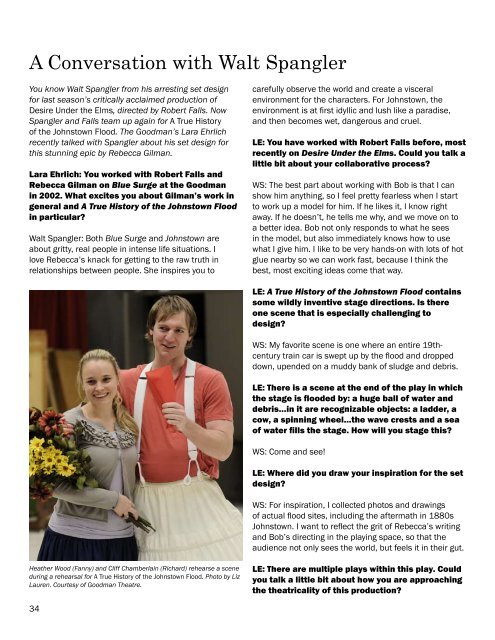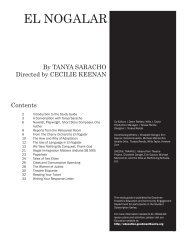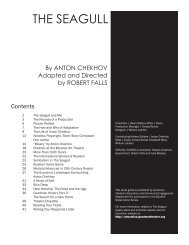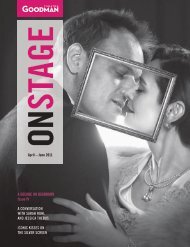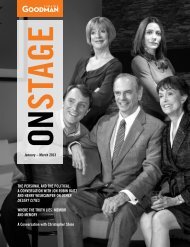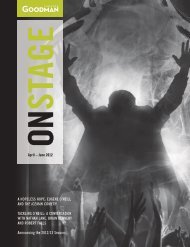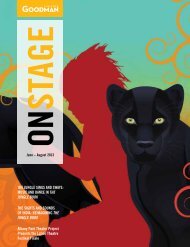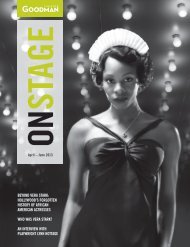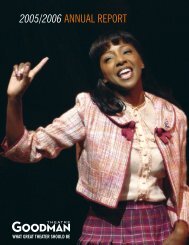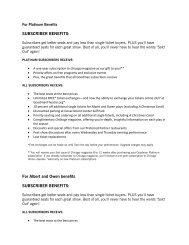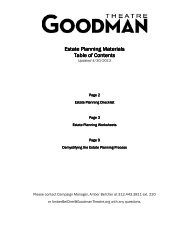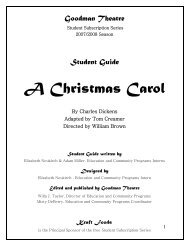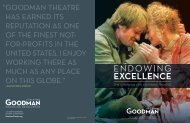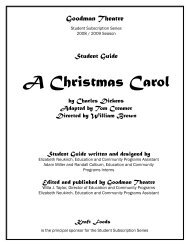A True History of the Johnstown Flood Study - Goodman Theatre
A True History of the Johnstown Flood Study - Goodman Theatre
A True History of the Johnstown Flood Study - Goodman Theatre
You also want an ePaper? Increase the reach of your titles
YUMPU automatically turns print PDFs into web optimized ePapers that Google loves.
A Conversation with Walt Spangler<br />
You know Walt Spangler from his arresting set design<br />
for last season’s critically acclaimed production <strong>of</strong><br />
Desire Under <strong>the</strong> Elms, directed by Robert Falls. Now<br />
Spangler and Falls team up again for A <strong>True</strong> <strong>History</strong><br />
<strong>of</strong> <strong>the</strong> <strong>Johnstown</strong> <strong>Flood</strong>. The <strong>Goodman</strong>’s Lara Ehrlich<br />
recently talked with Spangler about his set design for<br />
this stunning epic by Rebecca Gilman.<br />
Lara Ehrlich: You worked with Robert Falls and<br />
Rebecca Gilman on Blue Surge at <strong>the</strong> <strong>Goodman</strong><br />
in 2002. What excites you about Gilman’s work in<br />
general and A <strong>True</strong> <strong>History</strong> <strong>of</strong> <strong>the</strong> <strong>Johnstown</strong> <strong>Flood</strong><br />
in particular?<br />
Walt Spangler: Both Blue Surge and <strong>Johnstown</strong> are<br />
about gritty, real people in intense life situations. I<br />
love Rebecca’s knack for getting to <strong>the</strong> raw truth in<br />
relationships between people. She inspires you to<br />
carefully observe <strong>the</strong> world and create a visceral<br />
environment for <strong>the</strong> characters. For <strong>Johnstown</strong>, <strong>the</strong><br />
environment is at first idyllic and lush like a paradise,<br />
and <strong>the</strong>n becomes wet, dangerous and cruel.<br />
LE: You have worked with Robert Falls before, most<br />
recently on Desire Under <strong>the</strong> Elms. Could you talk a<br />
little bit about your collaborative process?<br />
WS: The best part about working with Bob is that I can<br />
show him anything, so I feel pretty fearless when I start<br />
to work up a model for him. If he likes it, I know right<br />
away. If he doesn’t, he tells me why, and we move on to<br />
a better idea. Bob not only responds to what he sees<br />
in <strong>the</strong> model, but also immediately knows how to use<br />
what I give him. I like to be very hands-on with lots <strong>of</strong> hot<br />
glue nearby so we can work fast, because I think <strong>the</strong><br />
best, most exciting ideas come that way.<br />
LE: A <strong>True</strong> <strong>History</strong> <strong>of</strong> <strong>the</strong> <strong>Johnstown</strong> <strong>Flood</strong> contains<br />
some wildly inventive stage directions. Is <strong>the</strong>re<br />
one scene that is especially challenging to<br />
design?<br />
WS: My favorite scene is one where an entire 19thcentury<br />
train car is swept up by <strong>the</strong> flood and dropped<br />
down, upended on a muddy bank <strong>of</strong> sludge and debris.<br />
LE: There is a scene at <strong>the</strong> end <strong>of</strong> <strong>the</strong> play in which<br />
<strong>the</strong> stage is flooded by: a huge ball <strong>of</strong> water and<br />
debris…in it are recognizable objects: a ladder, a<br />
cow, a spinning wheel…<strong>the</strong> wave crests and a sea<br />
<strong>of</strong> water fills <strong>the</strong> stage. How will you stage this?<br />
WS: Come and see!<br />
LE: Where did you draw your inspiration for <strong>the</strong> set<br />
design?<br />
WS: For inspiration, I collected photos and drawings<br />
<strong>of</strong> actual flood sites, including <strong>the</strong> aftermath in 1880s<br />
<strong>Johnstown</strong>. I want to reflect <strong>the</strong> grit <strong>of</strong> Rebecca’s writing<br />
and Bob’s directing in <strong>the</strong> playing space, so that <strong>the</strong><br />
audience not only sees <strong>the</strong> world, but feels it in <strong>the</strong>ir gut.<br />
Hea<strong>the</strong>r Wood (Fanny) and Cliff Chamberlain (Richard) rehearse a scene<br />
during a rehearsal for A <strong>True</strong> <strong>History</strong> <strong>of</strong> <strong>the</strong> <strong>Johnstown</strong> <strong>Flood</strong>. Photo by Liz<br />
Lauren. Courtesy <strong>of</strong> <strong>Goodman</strong> <strong>Theatre</strong>.<br />
LE: There are multiple plays within this play. Could<br />
you talk a little bit about how you are approaching<br />
<strong>the</strong> <strong>the</strong>atricality <strong>of</strong> this production?<br />
34


